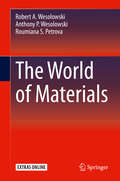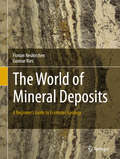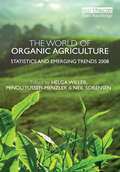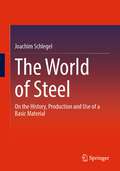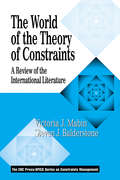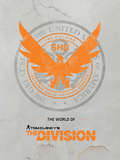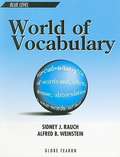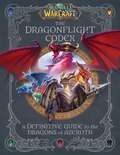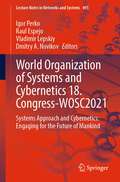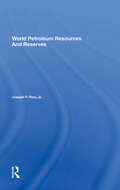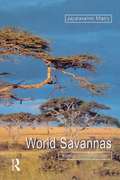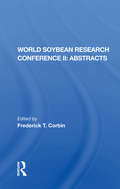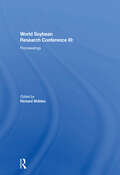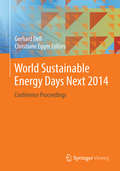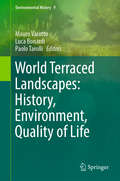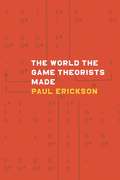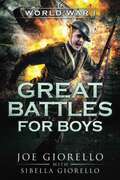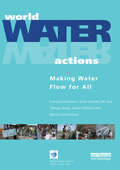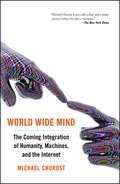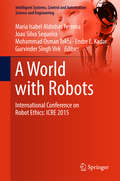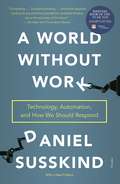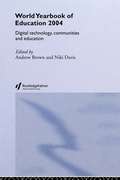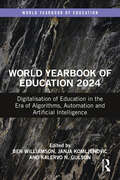- Table View
- List View
The World of Materials
by Robert A. Wesolowski Anthony P. Wesolowski Roumiana S. PetrovaThe world of materials is exciting because new materials are evolving daily. After an introduction to materials science, the book addresses the classification and structure of matter. It moves on to discuss crystal and mechanical properties. Next, the book employs various materials such as semiconductors and iron wires to teach concepts such as electrical conductivity, heat conductivity and allotropes. Corrosion is addressed and a chapter dedicated to interpretation of graphs and diagrams in materials science is presented. The book then progresses with chapters on ceramics, biomaterials, polymers and composites. To address the growing importance of recycling materials, polymer identification codes are explained. Interesting topics such as accidental materials discovery and materials failure are included. Each chapter ends with a chapter summary and questions and answers. Illustrations and worked examples are provided throughout. A lab manual is included as well.Presents an broad overview of materials science topics, including such topics as: crystal and mechanical properties of materials, semiconductors and iron wires, corrosion, ceramics, biomaterials, polymers, and composite materials;Examines modern-day materials, their synthesis, properties, alteration, and applications;Includes supplemental material, such as a lab manual and examples.
The World of Mineral Deposits: A Beginner's Guide to Economic Geology
by Florian Neukirchen Gunnar RiesThis vivid introduction to economic geology not only describes the most important deposit types, but also the processes involved in their formation. Magmatic, hydrothermal and sedimentary processes as well as weathering and alteration are explained in the framework of plate tectonics and the history of the Earth. The chapter about fossil fuels includes unconventional deposits and the much-debated fracking. Other topics covered are exploration, mining and economic aspects like commodity prices.
The World of Organic Agriculture: Statistics and Emerging Trends 2008
by Minou Yussefi-MenzlerThe new edition of this annual publication (previously published solely by IFOAM and FiBL) documents recent developments in global organic agriculture. It includes contributions from representatives of the organic sector from throughout the world and provides comprehensive organic farming statistics that cover surface area under organic management, numbers of farms and specific information about commodities and land use in organic systems. The book also contains information on the global market of the burgeoning organic sector, the latest developments in organic certification, standards and regulations, and insights into current status and emerging trends for organic agriculture by continent from the worlds foremost experts. For this edition, all statistical data and regional review chapters have been thoroughly updated. Completely new chapters on organic agriculture in the Pacific, on the International Task Force on Harmonization and Equivalence in Organic Agriculture and on organic aquaculture have been added. Published with IFOAM and FiBL
The World of Steel: On the History, Production and Use of a Basic Material
by Joachim SchlegelThe world of steel is constantly evolving and has become astonishingly diverse, indeed so complex that it is not easy to keep track of it in practice. The aim is to give readers an understanding of this world, from steelmaking, ingot and continuous casting, forming and machining to finishing, testing and packaging of the products, the processes and equipment predominantly used throughout, including the environmentally compatible recycling and disposal of waste.
The World of the Small Commercial Fishermen: Their Lives and Their Boats
by Michael MeltzerIncorporating elements of anthropology, marine biology, and marine technology, Michael Meltzer's story of men and boats weaves together actual interviews with fishermen from all three coasts, vivid descriptions of their lives, the ways of the communities in which they live, and many fascinating details -- about fishing vessels, fishing gear, and numerous kinds of fish.<P>From a salmon puller's story to fisherman's superstitions and harbor hierarchies, geologist-teacher Meltzer's account is colorful, serious, anecdotal, and informational.
The World of the Theory of Constraints: A Review of the International Literature (The CRC Press Series on Constraints Management)
by Victoria J Mabin Steven J BalderstoneThe Theory of Constraints (TOC) - as developed by Dr. Eliyahu Goldratt - has seen a rapid expansion since the publication of his book, The Goal. As with most fast growing areas, you can quickly feel out of touch with new developments. The World of the Theory of Constraints provides a summary of recently published research on TOC. The authors explored databases, and sought out papers and books drawing on as wide a range as possible. Aside from the works by Dr. Goldratt himself, the authors focus on items published since 1990, highlighting the most recent developments in TOC. The scope of the material covers works containing specific reference to TOC, including Synchronous Manufacturing and Constraint Management.The book is organized into three sections. The first section contains an analysis and interpretation of the results of the search. The second provides abstracts on all the material. The third supplies author, keyword, and subject indexes along with a list of books, journals, websites, and publishers. Extensively researched and referenced, The World of the Theory of Constraints furnishes comprehensive material on TOC. The multi-search approach has made this arguably the most exhaustive bibliography on this subject available. If you are researching TOC, this is the best place to start. If you use or teach TOC, you will want this resource.Features
The World of Tom Clancy's The Division
by UbisoftIncisive lore and detailed art in a cunningly designed hardcover that will bring readers into the ravaged streets of New York City and Washington DC as seen in Ubisoft's record-breaking videogame series!On Black Friday, a deadly biological attack was thrust upon the populace of New York. Within weeks, millions lay dead, and the city was placed under quarantine. The only force with any hope of restoring order are the embedded agents of the SHD--more commonly known as the Division. Despite the quarantine, the infection continues to spread across the country. Amidst a ruined government, a shattered infrastructure, and an eroding civilization, the Division is now called to action in Washington DC--but if the agents fail, the capital will fall, and the nation with it.The World of Tom Clancy's The Division is the meticulously crafted result of a partnership between Dark Horse books and Ubisoft Entertainment, offering readers a unique insight into the chaotic and dangerous world of the hit games. Don't miss this opportunity to learn all there is to know about the tactical methods, the high-tech tools, and the all-important mission of the Division!
World of Vocabulary, Blue Level (3rd Edition)
by Sidney J. Rauch Alfred B. WeinsteinWorld of Vocabulary, Blue Level, Third Edition contains brainstorming exercises for students to improve their vocabulary of the English language.
World of Vocabulary, Orange Level (3rd Edition)
by Sidney J. Rauch Zacharie J. ClementsThis book contains a lot of brainstorming exercises and practices for students to improve their vocabulary of the English language.
World of Warcraft: (A Definitive Guide to the Dragons of Azeroth) (WORLD OF WARCRAFT)
by Insight Editions Doug Walsh Sandra RosnerUncover the rich history of the legendary dragons of Azeroth with this official, lavishly illustrated guide from the iconic game World of Warcraft. With over 100 never-before-seen illustrations, World of Warcraft: Dragonflight Codex (A Definitive Guide to the Dragons of Azeroth) is the ultimate WoW fan&’s guide to everything dragons.Journey across Azeroth and beyond with this comprehensive guide, highlighting the magnificent dragons of the video game World of Warcraft. With this immersive in-world field guide written by Archmage Khadgar of the Kirin Tor, get an in-depth look at draconic species and the newly awakened dracthyr, along with the magical abilities of World of Warcraft&’s dragonflights, proto-dragons, and more! After enduring years of hardship, the dragons of Azeroth must reclaim their legacy, and it is more important than ever to learn about their vast history and incredible abilities. Though the Dragon Isles stood dormant for 10,000 years, now the Watcher has reawakened, the beacon has been lit, and the dragons have come home—called to be Azeroth&’s protectors once more. The New Age of Dragons has begun in World of Warcraft: Dragonflight. From the untamed northlands of Azeroth, fans of World of Warcraft will be able to follow the history of the dragons from their origins as elemental drakes to the present day dragonflights in this new, all-inclusive dragon codex. This fully illustrated, comprehensive guide will highlight the creatures&’ magical abilities, outline a chronological evolution of the dragons, and map out enchanting new zones. World of Warcraft: Dragonflight Codex (A Definitive Guide to the Dragons of Azeroth) is a must-have companion piece to the latest expansion, World of Warcraft: Dragonflight. 100+ ALL-NEW ILLUSTRATIONS: This in-depth bestiary features breathtaking all-new art from the latest expansion, World of Warcraft: Dragonflight IN-GAME CONCEIT: This guide to everything on the dragons of Azeroth is written by the wise wizard Khadgar, who fills the book with his insightful annotations COMPREHENSIVE GUIDE: World of Warcraft: Dragonflight Codex (A Definitive Guide to the Dragons of Azeroth) is packed with lore about the powerful creatures who hail from the northlands? LEARN ABOUT THE DRAGON ISLES: Discover new corners of Azeroth in full-color illustrations of the zones from latest expansion, World of Warcraft: Dragonflight OFFICIALLY LICENSED: Created in collaboration with Blizzard Entertainment COMPLETE YOUR COLLECTION: A is for Azeroth: ABC&’s of Warcraft, World of Warcraft: New Flavors of Azeroth: The Official Cookbook, and World of Warcraft: The Official Cookbook are also available from Insight Editions
World Organization of Systems and Cybernetics 18. Congress-WOSC2021: Systems Approach and Cybernetics: Engaging for the Future of Mankind (Lecture Notes in Networks and Systems #495)
by Igor Perko Raul Espejo Vladimir Lepskiy Dmitry A. NovikovImportant world institutions, such as the United Nations (UN), the World Health Organization (WHO), the International Energy Agency (IEA), and the Organization for Economic Co-operation and Development (OECD), have publicly recognizing the highly interconnected nature of our world and therefore the relevance of systemic thinking and cybernetics as leading knowledge foundations to deal with the complexity of economic, social, and environmental issues. This recognition was the driving force of the Internet discussions held by participants to the World Organisation of Systems and Cybernetics 18th Congress, which last September 27 to 29(WOSC 2021). More than ever we needed to debate and develop current ontological, epistemological, and methodological approaches to the understanding of the future of humanity.WOSC organized this event in collaboration with the Russian Academy of Sciences (RAS). Scientists of this Academy together with scientists from all over the world made contributions to improving communications beyond particular nation states and regions toward the clarification of global issues like governance, health, education, technology, art, and others. Our aim in WOSC 2021 was bringing together scientists and researchers to collaborative debates at all levels from local communities to global societies. At the end of the Congress, scientists were invited to submit contributions to this Springer Nature book, along the following four themes: firstly, philosophical and methodological foundations for the development of the systems approach and cybernetics; secondly, the cybernetics of society, ecology and governance; thirdly, digital technologies and physical realities merging into a hybrid reality , and fourthly, the transdisciplinarity of systems sciences and cybernetics applied to the further development of knowledge areas, such as education, embodiment of social policies, and the arts. About 25 contributions were accepted for publication in this book. We see this as one of WOSC’s important contribution to the scientific community around the world.
World Petroleum Resources And Reserves
by Joseph RivaThis book describes and analyzes the geological basis for the current world petroleum situation. It explains the formation and accumulation of conventional and unconventional oil and gas and the methods used by geologists in the search for petroleum and petroleum-containing basins.
World Savannas: Ecology and Human Use
by Jayalaxshm Mistry Andrea BeradiAn interdisciplinary text on the world's savannas, covering the geography, ecology, economics and politics of savanna regions. Savannas are a distinct vegetation type, covering a third of the world's land surface area and supporting a fifth of the world's population. There has been a wide range of literature on the subject, but the majority of work has focused on the ecology or development of savanna areas, ignoring the wider interdisciplinary issues affecting contemporary savannas. World Savannas aims to buck this trend, providing students with an up-to-date and comprehensive introduction to the global importance of savannas.
World Soybean Research Conference Ii, Abstracts
by Frederick T CorbinThe result of strong international interest in the soybean, the World Soybean Research Conference II was held March 26-29, 1979, at North Carolina State University. This volume contains summaries of the more than two hundred papers presented at that meeting. The authors, international authorities in their fields, represent sixteen areas of professi
World Soybean Research Conference III: Proceedings
by Richard ShiblesThis volume consists of full length manuscripts of 159 of the 165 invited papers presented at World Soybean Research Conference III that was held in the Scheman Continuing Education Building at Iowa State University August 12-17, 1984. The authors, widely recognized as world authorities in their fields, represent all aspects of soybean research activity: breeding and genetics, crop and soil management, economics, entomology, food science, international programs, nematology, pathology, physiology, plant nutrition, rhizobiology, utilization, and weed science. This proceedings, which contains more than 1200 pages of information including many tables and figures, represents the most extensive compilation of soybean research results since the previous proceedings were published in 1980. It should be of value to research scientists, students and administrators alike.
World Sustainable Energy Days Next 2014
by Gerhard Dell Christiane EggerThese conference proceedings contain contributions to one of Europe's largest annual conferences on energy efficiency and renewable energy. From two main fields - biomass and energy efficiency in buildings - contributions offer an insight into the research work and the scientific findings and developments of young researchers from all over the world. The papers were selected by a high-level scientific committee for oral presentation. They also communicate results, trends and opinions that will concern and influence the world's energy experts and policy makers over the next decades. The conference was held from 26-27 February 2014.
World Terraced Landscapes: History, Environment, Quality of Life (Environmental History #9)
by Mauro Varotto Luca Bonardi Paolo TarolliThis volume collects the best scientific contribution presented in the 3rd World Conference on Terraced Landscapes held in Italy from 6th to 15th October 2016, offering a deep and multifaceted insight into the remarkable heritage of terraced landscapes in Italy, in Europe and in the World (America, Asia, Australia). It consists of 2 parts: a geographical overview on some of the most important terraced systems in the world (1st part), and a multidisciplinary approach that aims to promote a multifunctional vision of terraces, underlining how these landscapes meet different needs: cultural and historical values, environmental and hydrogeological functions, quality and variety of food, community empowerment and sustainable development (2nd part). The volume offers a great overview on strengths, weaknesses, functions and strategies for terraced landscapes all over the world, summarizing in a final manifest the guidelines to provide a future for these landscapes as natural and cultural heritage.
The World the Game Theorists Made
by Paul EriksonIn recent decades game theory--the mathematics of rational decision-making by interacting individuals--has assumed a central place in our understanding of capitalist markets, the evolution of social behavior in animals, and even the ethics of altruism and fairness in human beings. With game theory's ubiquity, however, has come a great deal of misunderstanding. Critics of the contemporary social sciences view it as part of an unwelcome trend toward the marginalization of historicist and interpretive styles of inquiry, and many accuse its proponents of presenting a thin and empirically dubious view of human choice. The World the Game Theorists Made seeks to explain the ascendency of game theory, focusing on the poorly understood period between the publication of John von Neumann and Oscar Morgenstern's seminal Theory of Games and Economic Behavior in 1944 and the theory's revival in economics in the 1980s. Drawing on a diverse collection of institutional archives, personal correspondence and papers, and interviews, Paul Erickson shows how game theory offered social scientists, biologists, military strategists, and others a common, flexible language that could facilitate wide-ranging thought and debate on some of the most critical issues of the day.
World War I (Great Battles for Boys)
by Joe Giorello Sibella GiorelloYoung readers experience an unforgettable journey into World War I. They learn about the major battles, leaders, tactics, and strategies that helped the Allies topple the Axis powers. They'll also learn about new inventions, such as airplanes and tanks, which proved crucial to “The Great War." <p><p> Among the battles covered: <p> • Battle of Tannenberg: outnumbered German soldiers plan a sneak attack that destroys Russian forces, capturing 150,000 prisoners of war. <p>• Battle of the Somme: One of military history’s worst follies, this battle ended with more than one million casualties—and yet achieved almost nothing for either side. <p>• Battle of Cantigny: A little-known battle that proved the late-arriving American forces reached the Western Front ready to win. <p><p> Other chapters cover WWI’s most fascinating figures, such as Lawrence of Arabia, Sergeant York, the Harlem Hellfighters, and world events, including the Russian Revolution of 1917.
World Water Actions: Making Water Flow for All
by Francois GuerquinThis text is divided into three parts. Part I focuses on the need for management to assess the challenges of water scarcity and plan changes based on proper valuation and financial instruments, international co-operation and efficient use. Part II analyses the problems of water scarcity and the available solutions in each main sector: water supply and sanitation, energy, health, agriculture, ecosystems and biodiversity. Part III assesses the state of the debate following the third World Water Forum and sets out the priorities for action, including increased investment, institutional reform and capacity building in the water sector. Downloadable resources with extensive case studies and statistical data accompanies this text.
World Wide Mind: The Coming Integration of Humans and Machines
by Michael ChorostWhat if digital communication felt as real as being touched? This question led Michael Chorost to explore profound new ideas triggered by lab research around the world, and the result is the book you now hold. Marvelous and momentous, World Wide Mind takes mind-to-mind communication out of the realm of science fiction and reveals how we are on the verge of a radical new understanding of human interaction. Chorost himself has computers in his head that enable him to hear: two cochlear implants. Drawing on that experience, he proposes that our Paleolithic bodies and our Pentium chips could be physically merged, and he explores the technologies that could do it. He visits engineers building wearable computers that allow people to be online every waking moment, and scientists working on implanted chips that would let paralysis victims communicate. Entirely new neural interfaces are being developed that let computers read and alter neural activity in unprecedented detail. But we all know how addictive the Internet is. Chorost explains the addiction: he details the biochemistry of what makes you hunger to touch your iPhone and check your email. He proposes how we could design a mind-to-mind technology that would let us reconnect with our bodies and enhance our relationships. With such technologies, we could achieve a collective consciousness--a World Wide Mind. And it would be humankind's next evolutionary step. With daring and sensitivity, Chorost writes about how he learned how to enhance his own relationships by attending workshops teaching the power of touch. He learned how to bring technology and communication together to find true love, and his story shows how we can master technology to make ourselves more human rather than less. World Wide Mind offers a new understanding of how we communicate, what we need to connect fully with one another, and how our addiction to email and texting can be countered with technologies that put us--literally--in each other's minds.
A World with Robots: International Conference on Robot Ethics: ICRE 2015 (Intelligent Systems, Control and Automation: Science and Engineering #84)
by Maria Isabel Aldinhas Ferreira Joao Silva Sequeira Mohammad Osman Tokhi Endre E. Kadar Gurvinder Singh VirkThis book contains the Proceedings of the International Conference on Robot Ethics, held in Lisbon on October 23 and 24, 2015. The conference provided a multidisciplinary forum for discussing central and evolving issues concerning safety and ethics that have arisen in various contexts where robotic technologies are being applied. The papers are intended to promote the formulation of more precise safety standards and ethical frameworks for the rapidly changing field of robotic applications. The conference was held at Pavilh#65533;o do Conhecimento/Ci#65533;ncia Viva in Lisbon and brought together leading researchers and industry representatives, promoting a dialogue that combines different perspectives and experiences to arrive at viable solutions for ethical problems in the context of robotics. The conference topics included but were not limited to emerging ethical, safety, legal and societal problems in the following domains: * Service/Social Robots: Robots performing tasks in human environments and involving close human-robot interactions in everyday households; robots for education and entertainment; and robots employed in elderly and other care applications * Mobile Robots: Self-driving vehicles, autonomous aircraft, trains, cars and drones * Robots used in medicine and for therapeutic purposes * Robots used in surveillance and military functions
A World Without Work: Technology, Automation, and How We Should Respond
by Daniel SusskindA New York Times Book Review Editors’ ChoiceFrom an Oxford economist, a visionary account of how technology will transform the world of work, and what we should do about itFrom mechanical looms to the combustion engine to the first computers, new technologies have always provoked panic about workers being replaced by machines. For centuries, such fears have been misplaced, and many economists maintain that they remain so today. But as Daniel Susskind demonstrates, this time really is different. Breakthroughs in artificial intelligence mean that all kinds of jobs are increasingly at risk.Drawing on almost a decade of research in the field, Susskind argues that machines no longer need to think like us in order to outperform us, as was once widely believed. As a result, more and more tasks that used to be far beyond the capability of computers – from diagnosing illnesses to drafting legal contracts, from writing news reports to composing music – are coming within their reach. The threat of technological unemployment is now real.This is not necessarily a bad thing, Susskind emphasizes. Technological progress could bring about unprecedented prosperity, solving one of humanity’s oldest problems: how to make sure that everyone has enough to live on. The challenges will be to distribute this prosperity fairly, to constrain the burgeoning power of Big Tech, and to provide meaning in a world where work is no longer the center of our lives. Perceptive, pragmatic, and ultimately hopeful, A World Without Work shows the way.
World Yearbook of Education 2004: Digital Technologies, Communities and Education (World Yearbook of Education)
by Andrew Brown Niki DavisA real revolution is taking place in the way in which we conceptualise and practise education and learning. This book sets out to explore the immense impact which digital technology is having on education around the world and the ways in which it is used by a wide range of individuals and communities.Contributors analyse changes in technology such as e-mail, the Internet, digital video and other media, but also the effect of this new technology on the way people live and learn around the world.Cultural changes taking place range from the blurring of boundaries between formal and informal learning to the development of new 'virtual communities' which revolve around particular social or cultural interests, and which serve as a crucial tool and source of identity for spatially displaced communities such as refugees.Digital technology is changing the way we all live, and this book is an authoritative study of these changes in all their diversity.
World Yearbook of Education 2024: Digitalisation of Education in the Era of Algorithms, Automation and Artificial Intelligence (World Yearbook of Education)
by Ben Williamson Janja Komljenovic Kalervo N. GulsonProviding a comprehensive, global overview of the digitalisation of education, the World Yearbook of Education 2024 examines the ways advanced digital technologies are transforming educational practices, institutions and policy processes.Establishing a critical research agenda for analysing the digitalisation of education, the carefully selected chapters in this collection interrogate the current impacts of new digital technologies, emerging controversies over emerging data practices and future implications of algorithmic systems, automated decision-making and AI in education. Organised into four sections, the contributions in the collection examine the following: The historical, scientific and technical foundations of contemporary digitalisation in education The political and economic dynamics that underpin the education technology industry and new platform models of education How algorithms, automation and AI support new modes of data-driven governance and control of education systems Controversies over the inequitable effects of digitalisation in education, and proposals for data justice, ethics and regulation This resource is ideal reading for researchers, students, educational practitioners and policy officials interested in understanding the future of digital technologies in education.
